Since 1999
Designed by Faust Ltd. & Michael Workman Studio
This program is partially supported by a grant from the Illinois Arts Council Agency. This project is partially funded by the National Endowment for the Arts.
Bridge is a proud member of the following alliances:
Welcome to Bridge. Only the most recent season of magazine articles is available here. Please click here to create an account & access past articles, general archives, the new Bridge Video streaming service, also updated weekly in-season, & more.
Featured from the archives: click the poem to read the second of two poems from Szymborska featured in Bridge V1N3, pages 106-107.
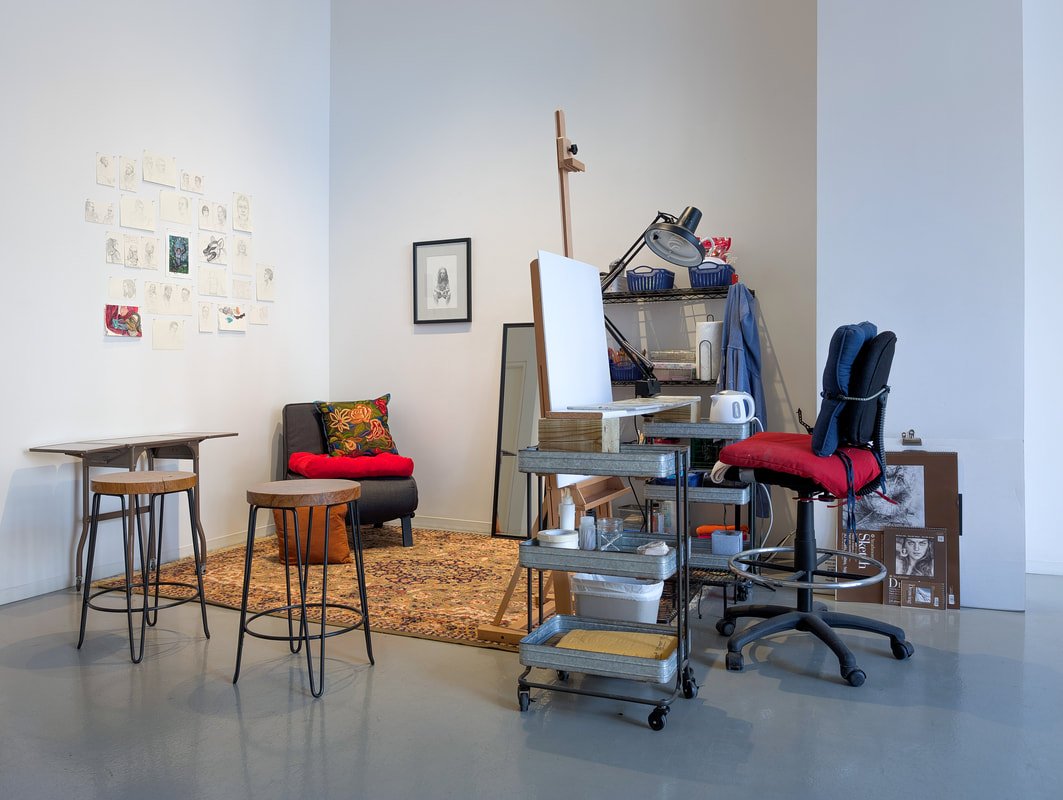
REVIEW: Riva Lehrer, “The Monster Studio” at Zolla/Lieberman Gallery
I could spend days wondering if I should’ve chosen differently or how I could've said it another way filling myself with dread as those thoughts pick me apart. Could I imagine confronting myself in front of an audience while trying to paint or draw that feeling? Gods, no. In The Monster Studio, Riva Lehrer invites authors, performers, podcasters, a sculptor, art critic and theorist to do just that. To think of themselves as agents of change, how they are disruptors in the world and to see themselves as “actors rather than acted upon.” Collaborators join Lehrer in a smaller, private recreation of her studio for a public conversation on the idea of the monster.
Furthering the collaborative aspect, audience members are welcomed to share their thoughts and questions in their own way disrupting the flow and find themselves a voice in what would otherwise be a private conversation. Bringing a subject together with the audience to explore some shared feelings practices a communal bonding that I feel continues to turn Lehrer’s practice inside-out. At the end of their sessions, the pieces are hung in the front of the gallery for everyone to come and enjoy.
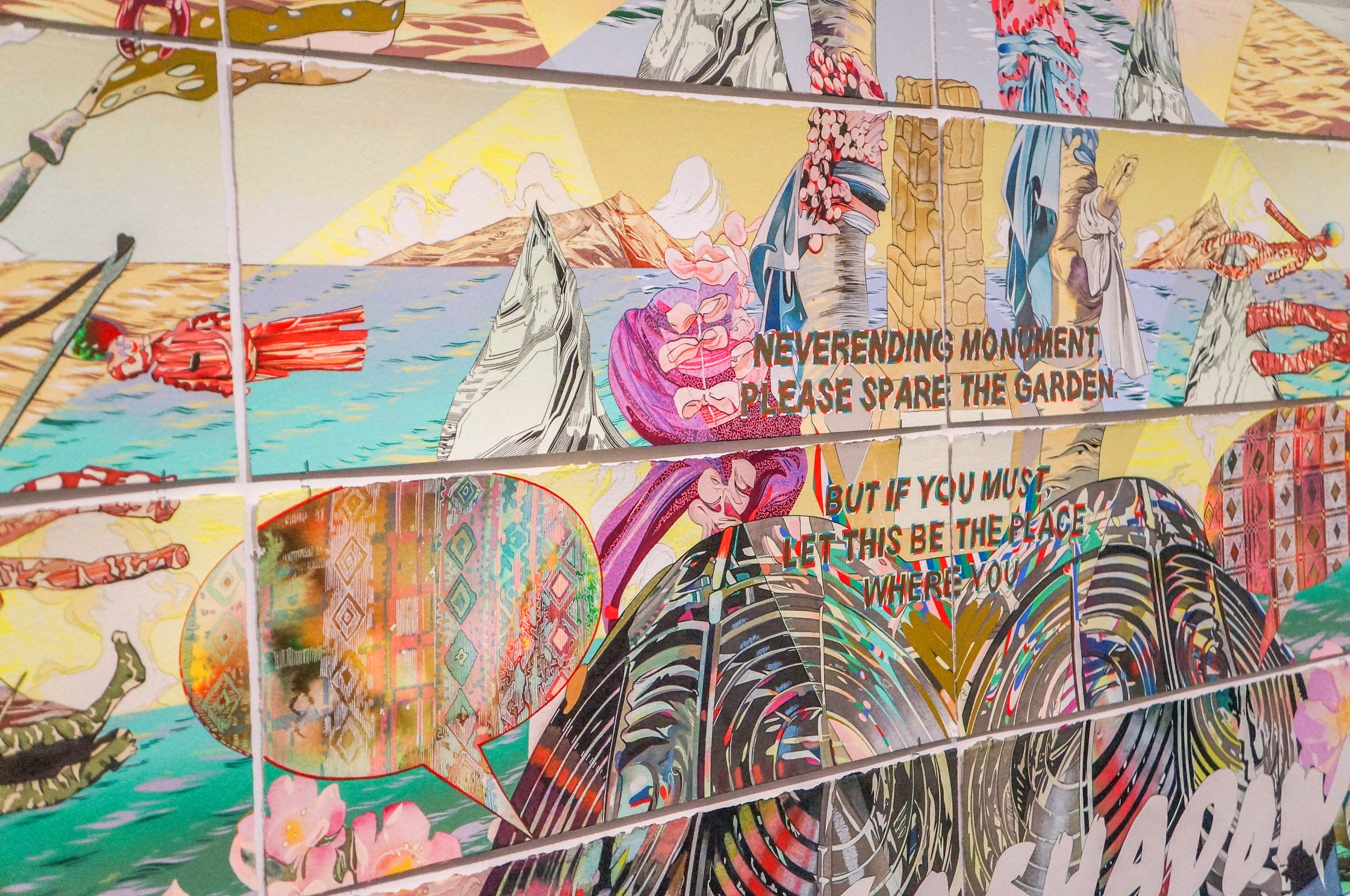
REVIEW: Filling the Absence in the Landscape: Andrea Carlson, “Shimmer on Horizon” at the MCA Chicago
Andrea Carlson speaks gently in a short documentary for her exhibition at the MCA: “Historically, landscape painting is violent. It’s about possession of the land, even though it might be plastered over with beautiful lighting and vast views: it’s based on empty landscape. Well, how did the landscape get emptied?”
Andrea Carlson: Shimmer on Horizon is the latest of MCA’s Chicago Works series. In this exhibit, the artist invites the viewer to investigate the dehumanizing nature of landscape paintings, which excavate the surroundings of their memories, identities, symbols, culture, creatures, people, heritages, and histories.
Landscape paintings hold a special romantic position in art history. The wall paintings in the Greek and Roman eras captured the marvels of the great empires, followed by religious paintings using the forests and creeks as the backdrop of divine encounters. In the 16th century, the landscape began to be regarded as an independent subject, corresponding to the rising interest in the natural world during the Renaissance era. Classical landscapes, modernist landscapes, impressionist landscapes, even photography…the sceneries have changed, but some characteristics of landscape art remained painfully cohesive: the brutal suspension of the land into statisity.
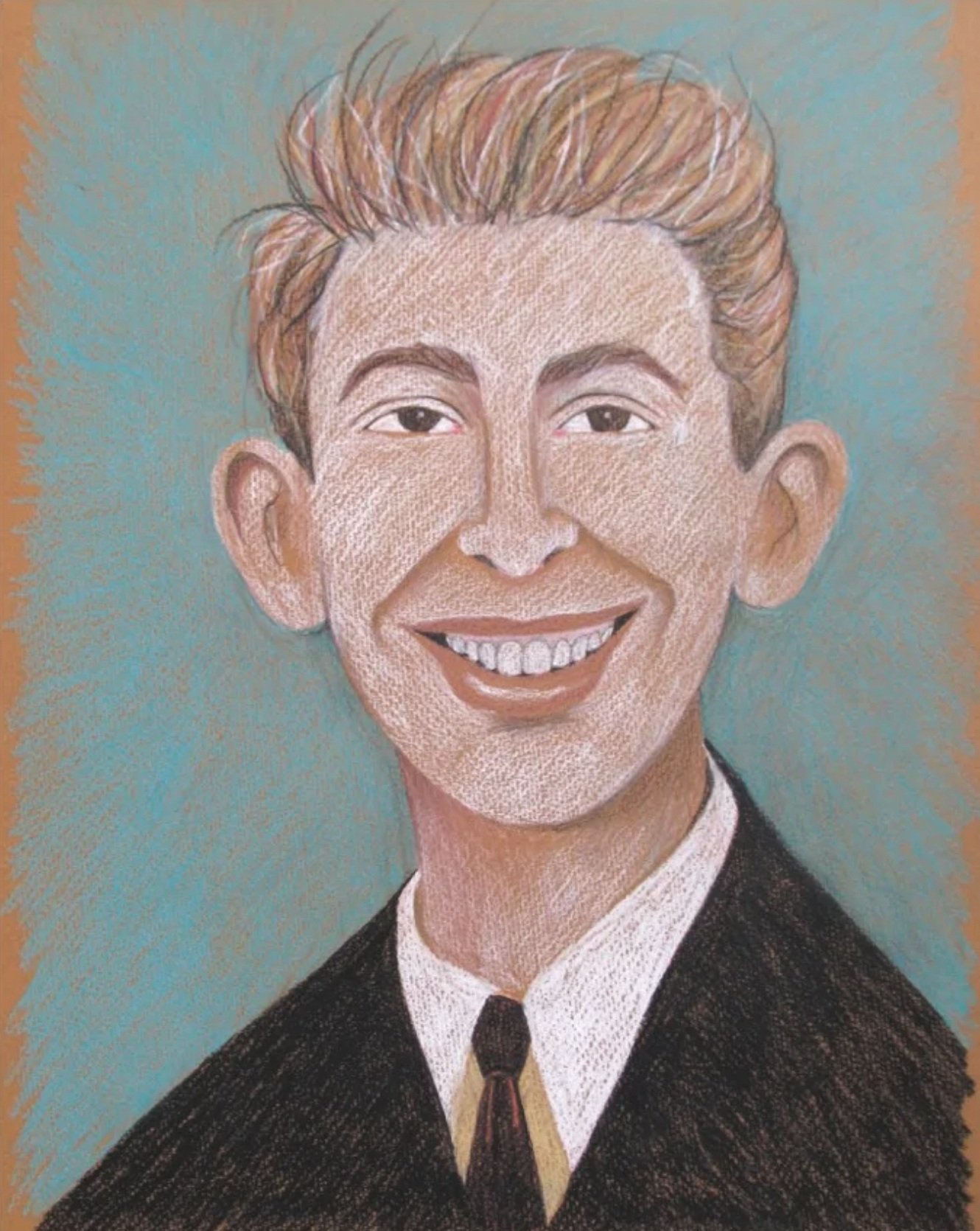
REVIEW: To See Heaven in a Wallflower: Heather McAdams, “How Do Ya Like Me Now?” at Firecat Projects
Heather McAdams was a legendary name in Chicago during the halcyon seventies and eighties, when her wackadoodle comics appeared regularly in the Chicago Reader. The shambling goofballs who frequented her panels—which, unlike the blockheaded vulgarity of the 60s comix scene, opted for risible personal anecdotes—effected a congeniality among viewers that only her rough-around-the-edges style could achieve. Decades after her long stint at the Reader, McAdams’s career is being memorialized at Firecat Projects, where a smorgasbord of work from recent years is on display.
McAdams wasn’t a vocational cartoonist by any means. She started at the Reader to fund her true passion, avant-garde filmmaking. (Every bit as bumbling and aimless as the characters in her panels, when she did make her foray into the world of movies, she frequently introduced herself as “a part-time cartoonist, performance artist, film instructor, junk salesperson, sculptor, painter, movie star, and ardent supporter of the Woolworth’s lunch counter.” (Layer upon layer of camp.) But her cartoons began a fecund artistic practice that came to encompass pencil and watercolor portraits, which make up the bulk of this show.
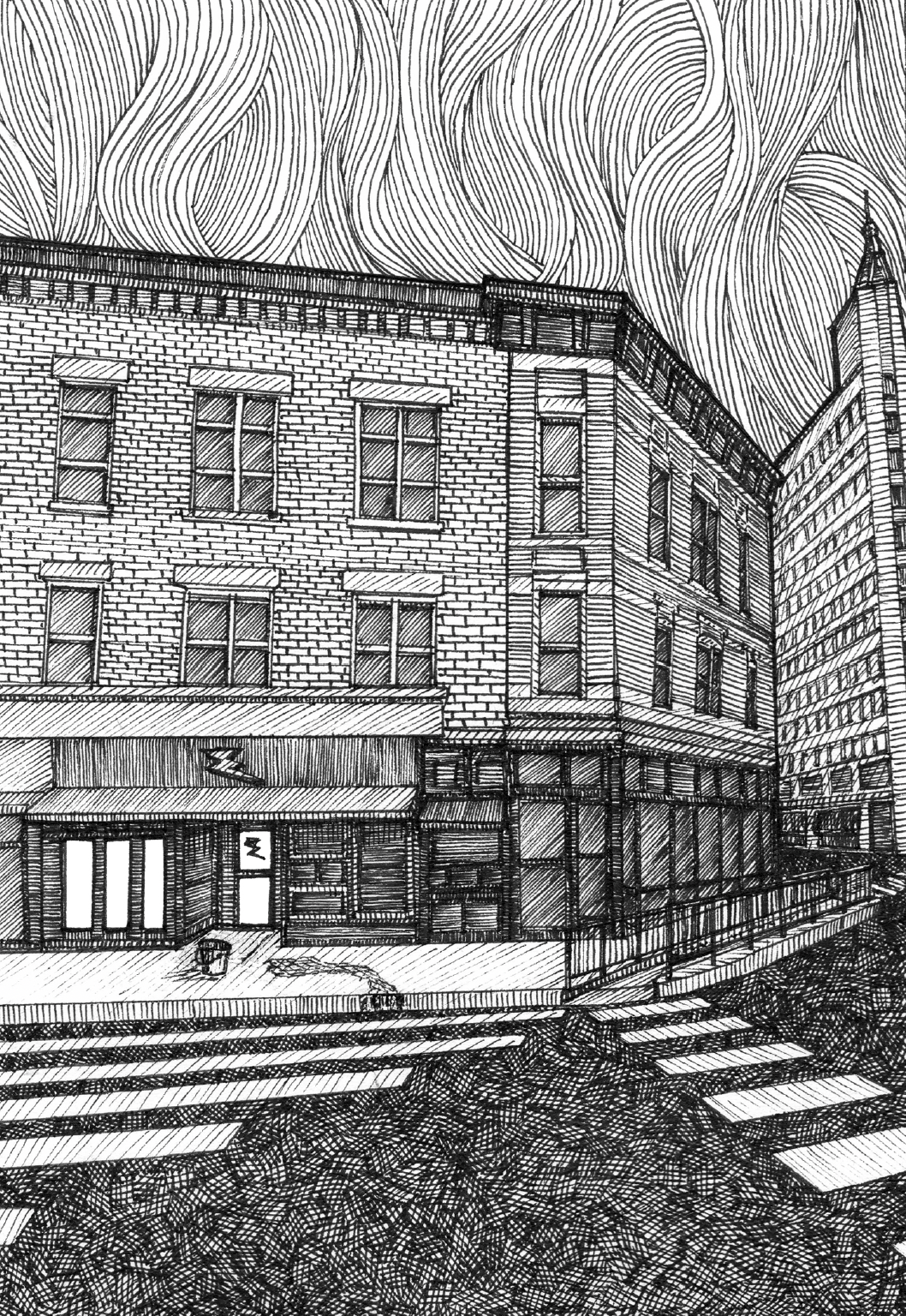
FICTION: “Dispatch from the Chaos,” by Jesse Darnay
I’d passed out on a frail settee, legs dangling over an arm, the leopard print button-down I’d bought at Brown Elephant torn along a flank. On the top unit of a weathered three-flat. Piles of videocassettes lined the walls. Potted ivies decayed on a windowsill. A stuffed, one-eyed macaw sat perched in a birdcage on a bulging U-Haul box. The stench of fungal tomatoes wafted from a ripped Hefty bag dumped by the front door.
“You need to go,” the woman said.
“Easy,” I told her. “Where am I?”
She broke apart cookie dough on her kitchenette counter. “Logan. Get out.”
This pre-dawn birdie I remembered had been a suave master of gargantuan sexuality. Complete lack of hesitation to caress Evan Junior, in public, at her whim, but at the same time not touching it gratuitously, only at those pitch-perfect moments when our eyes locked and the liquor lightening was flashing. Talking the way that erotic goddess still strutting through the jazzy ghettos of my memory would move her petite, jeans-bound ass in slow-motion samba and at the same time keep her head still as an Ancient Greek bust.
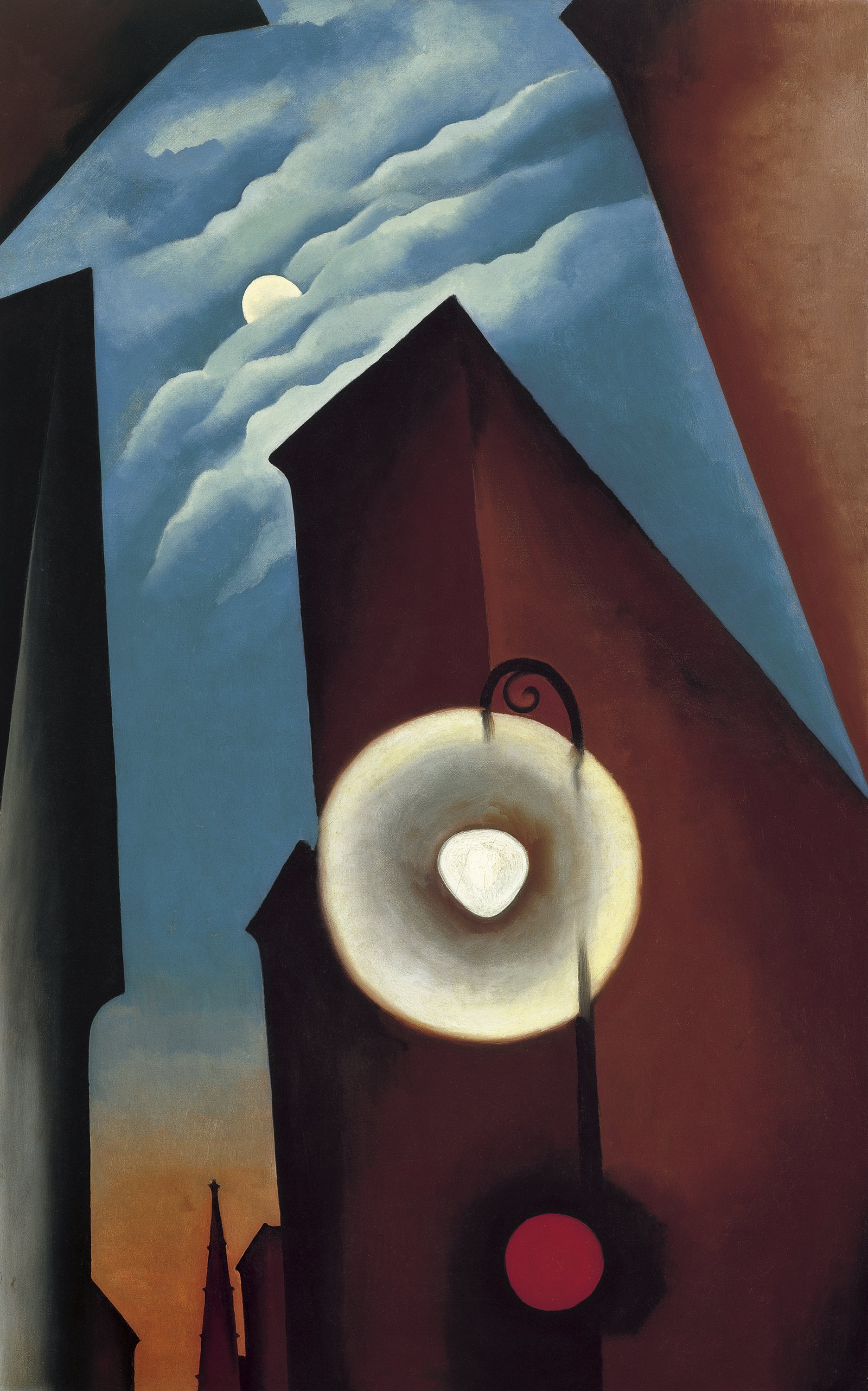
REVIEW: Georgia O’Keeffe “My New Yorks” at the Art Institute of Chicago
“To create one’s own world takes courage.” I first encountered this quote when visiting the Georgia O'Keeffe Museum in New Mexico and her estate at Ghost Ranch, where I was introduced to her work. I’m not often one who is deeply impacted by quotes, but once I read this sentence in 2020, Georgia O'Keeffe's words became the first day of the rest of my life. At the time, something struck me about her work that I could not understand as a budding artist. But I’m not the only one O’Keeffe has inspired.

REVIEW: Refined Randomness: Ellsworth Kelly’s “Spectrum Colors Arranged by Chance” at the Art Institute of Chicago
The current exhibition at the Art Institute of Chicago titled “Ellsworth Kelly: Spectrum Colors Arranged by Chance” brings together for the first time the complete series of collages that Kelly produced in Paris between 1951 and 1953. The series consists of nine works on paper and one painting made in September of 1953 to bring the investigation to completion. The format of the works consists of one initial longish rectangle and then eight squares “arranged by chance in a 40-inch-wide grid formation” (quoted from the exhibitions literature). Again, as stated in the exhibition notes, these works were produced during a crucial phase of development in the artist’s career.
At the time, Kelly was continuing to move away from his traditional atelier type education of drawing from the figure in the morning and painting from the figure in the afternoon and these collages deepened his commitment to chance-based techniques and non-compositional strategies. Kelly was also attracted to papier gomette, a commercially produced “gum-backed colored paper commonly used by French schoolchildren” in 20 available colors in order to free himself from expected color combinations. He was also attracted by the humble nature of the material to undercut the work as a precious art object.

REVIEW: “Christina Ramberg: A Retrospective” at the Art Institute of Chicago
Personal adornment is as much a form of concealing as revealing. I approach “Christina Ramberg: A Retrospective” from the perspective of fashion. The artist was a painter who knew how to sew, holding a lifelong fascination with fashion, observing its trends, ideals, and fetishes with a critical eye since her early years watching her mother get dressed. The artist made much of her own clothing, given fashion’s limited offerings for a woman of her 6’ 1” stature. Fashion was one of many visual sources that fueled Ramberg’s creative practice.
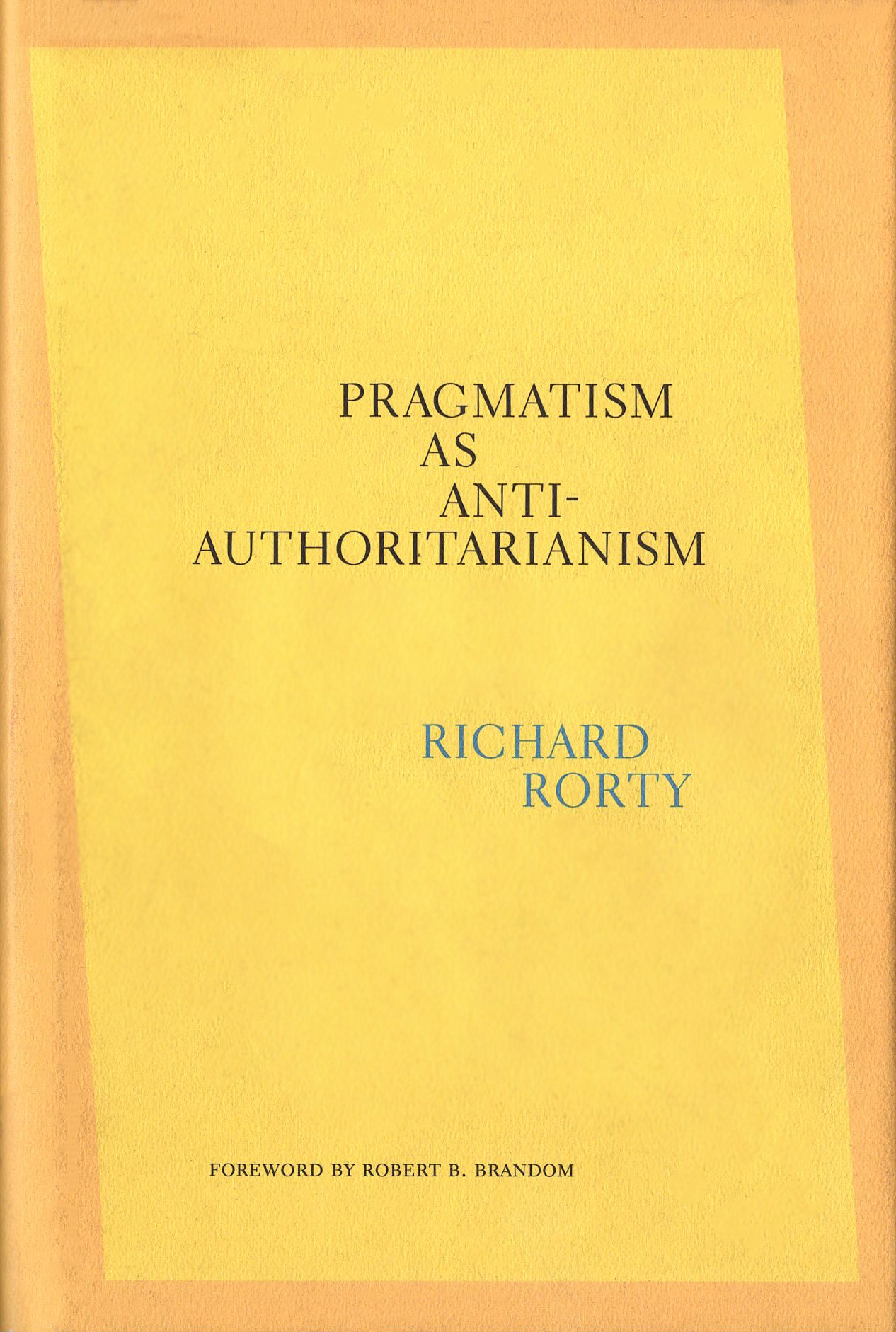
REVIEW: Richard Rorty, "Pragmatism as Anti-Authoritarianism"
A little setup to get us going. The opening lines (in part) of the interview with Richard Rorty in Volume 2, number 2 of the Bridge Journal by Sam Fleischacker are:
“Philosophers used to be heavily in the business of arguing for or against religious faith of various kinds. Most of us have stopped doing that, but in a time where the return to a very traditional and non-rational Christianity, Islam and Judaism has become such a prominent, and dangerous, feature of the world’s political landscape, isn’t this a job to do which we should return? On your views, though, it would be difficult to do that, no?
“It was in great part to prove or disprove the existence of God, miracles, an afterlife, etc. that much of the heavy machinery of the metaphysical and epistomological systems you oppose was developed. It is hard to imagine launching a useful argument on these questions using merely the tools of science, literature, or its political rhetoric. So if you agree with me that it is imperative to return to that issue—and maybe you don’t—how would you think we should go about doing it?”

REVIEW: Pooja Pittie: “Only in Dark the Light” at McCormick Gallery
“‘Only in Dark the Light’ is Pooja Pittie’s third solo exhibition at McCormick Gallery, which has represented the artist since 2016. The seven paintings and three fiber art installations on view were made in 2023 and 2024. The paintings build upon yet depart from the artist’s previous work, while the fiber art carries her evocative abstraction, exuberant color, and irregular lines into a new medium.
“My first impression of the show was formed on the sidewalk. Two intriguing works—’Nowhere to Hide’ and ‘Be in Softness’—were on view through the windows. Nowhere to Hide is a 40-inch square of colors laid in rhythmic, choppy strips. I misperceived it as collage, but once in the gallery, saw that it was canvas painted with acrylics—greens, yellows, reds, and blues washed the surface like watercolors. What I had seen as collage were actually wavering lines in the foreground that appeared to segment the color-washed background into strips.”

FICTION: “Henry Goes to Dancing School” by Richard Holinger
A late October Saturday night wind off the lake cut through Henry’s bulky olive winter parka, prickly wool suitcoat, and button-down, heavily starched white shirt. Before dinner, playing two-hand touch anywhere in Lincoln Park, low clouds had threatened snow. Now, yellow streetlights lit the Inner Drive’s sidewalk as Wes and Henry slogged their way south to the Fortnightly.

INTERVIEW: Curator Jadine Collingwood On Nicole Eisenman’s, “What Happened” at the MCA Chicago
The morning of the press event for Nicole Eisenman: What Happened at the MCA, I am so nervous I get downtown an hour early. I feel underqualified, underprepared, and underdressed, and I haven’t even made it into the building. I wonder if I should have brought some kind of felt hat with an index card that says PRESS. I fear they won’t even let me in the front door without my ‘PRESS’ hat, and I frantically google milliners near me. The MCA is large and imposing, and I feel very small and meek and hatless.
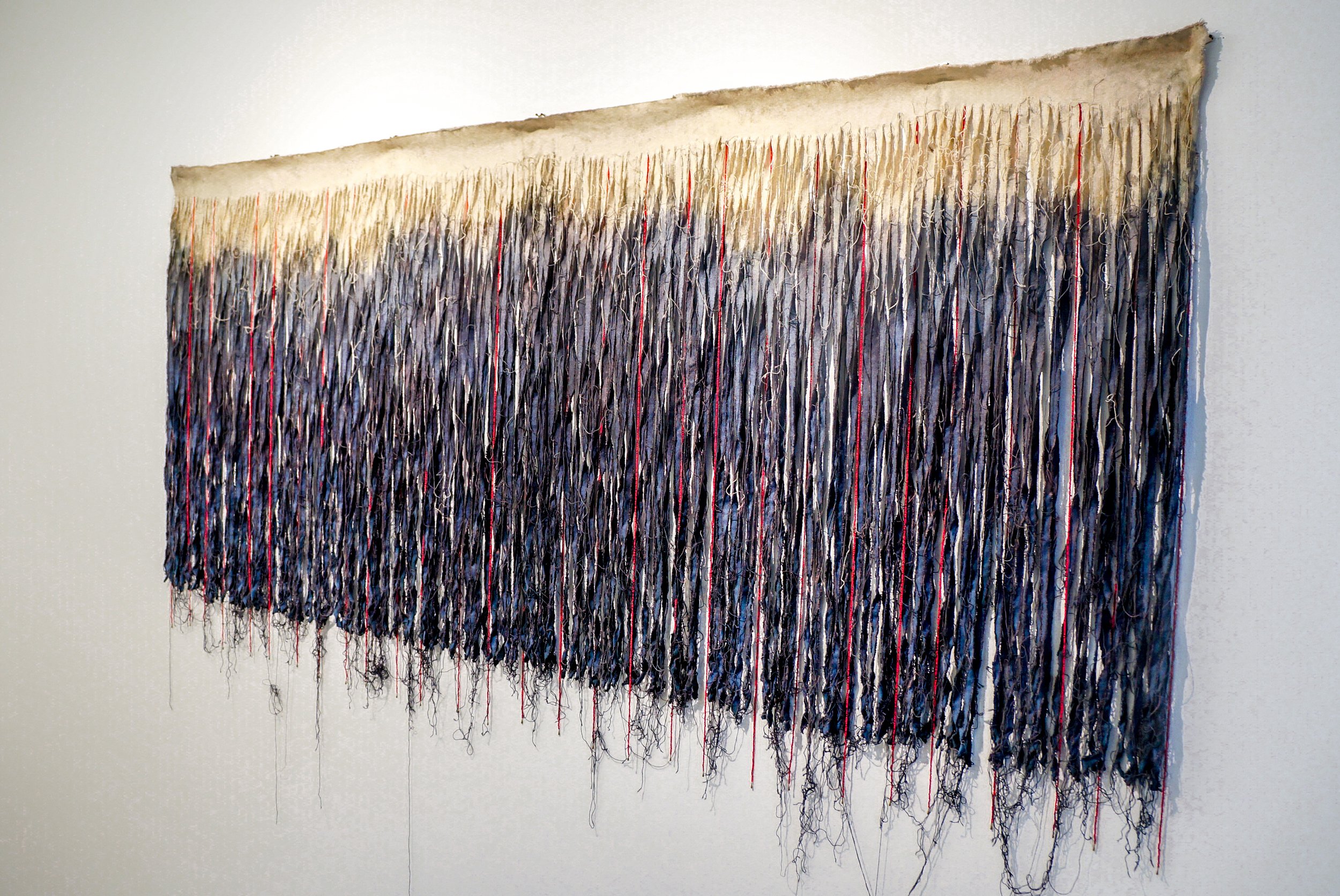
REVIEW: Building On Heritages and Reclaiming Indigeneity: “Native Futures” at the Center for Native Futures
“Museums can be very painful sites for Native peoples, as they are intimately tied to the colonization process,” Amy Lonetree, a Ho-Chunk Nation art historian, wrote in the Introduction of Decolonizing Museums: Representing Native America in National and Tribal Museums [1]. For decades, the public has shaped their understanding of the Native people and their culture around museum and curator-led collections and exhibitions that are often outdated and unrepresentative, erasing not only the indigenous community’s history and heritage but also the progression and development.
As such, indigenous people must reclaim their collective identity.

REVIEW: Intimate Encounters: dropshift dance, “Rooms” at Colvin House
The historic Colvin House, a 1909 Prairie style house by architect George Maher, was the setting for dropshift dance’s newest evening length production Rooms. The piece, “a sensory recapitulation of our past” was the culmination of a two-year process that brought together 3 sections of the work, DWELL/burrow, bloom and objects, that had previously been performed separately.

REVIEW: “Absolute Animal” by Rachel DeWoskin
Rachel DeWoskin’s book is a journey through feelings, behaviors, and actions. The poems within act as a bridge of expression between how all living fauna act on their experiences. There are tales of traveling, taxidermy, fear, the loss of a father figure, and everything in between. The perspectives range from within, be that an inner animal, an inner child, or whatever voice that controls someone’s impulse.

FICTION: “Dead Skin” by Maria Giron
I read a study once that said our idea of pain was stronger in the present than when we were asked to recall it later. We’ll say “It wasn’t so bad after all” when it had been bloody shitty. Just like school. The nostalgia of the place. Maybe the more you suffered someplace, the more you missed it. The more that place made you. So, sometimes, we come back to it.
Life outside was dull. Faded out. Too many spins in the washing machine. Bits and pieces coming out smaller and dimmer. Waiting in line at the grocery store, thinking “Shit you forgot to weigh oranges, did you have time to go back and weigh them while leaving the rest of the groceries on the automatic belt by the cashier?” People stood behind me. A girl with a pack of tampons and an ice-cream birthday cake beginning to melt. An old guy with dog food and six bottles of coke. I just wanted to curl into a ball. So I left all my groceries on the belt, and walked out, just as the cashier's voice shouted, "Who's groceries are these? Hey? hey!" and I was gone.
![PREVIEW: “[we don’t know yet] what cinema can do:” Onion City Film Festival at Public Works](https://images.squarespace-cdn.com/content/v1/5e34d387d2a0e803a2f5cd65/933f9b14-156a-402e-9efd-e945e40534c8/Screenshot+2024-03-31+at+8.53.57%E2%80%AFPM.png)
PREVIEW: “[we don’t know yet] what cinema can do:” Onion City Film Festival at Public Works
The Onion City Film Festival returns to Chicago April 4 and will run for ten days. Programmed by curator, writer and LITHIUM/TNL gallery co-founder Nicky Ni, the festival highlights experimental film and video art from internationally renowned artists. On April 5, the festival will join with the Center for Concrete and Abstract Machines [CCAM] to host [we don’t know yet] what cinema can do - a night of live A/V performances alongside three installations - at Public Works.
“The Question of Grief” (2023), a piece by Liyan Zhao incorporating lecture, light, sound and found footage, will interrogate the nature of grief and its effect on imagination and folklore. Hunter Whittaker-Brown’s “The Emissary (A Prayer)” (2024) is a vocal piece with live sound and visual processing. Brown’s work is informed by Black cosmology and Afrofuturism, and looks at mass media through an archival lens. “I am invested in breaking down the form of moving image and further unpacking the possibilities of its reconfiguration as a synecdochic act of disassembling and remaking contemporary culture at large,” Brown wrote of this piece.
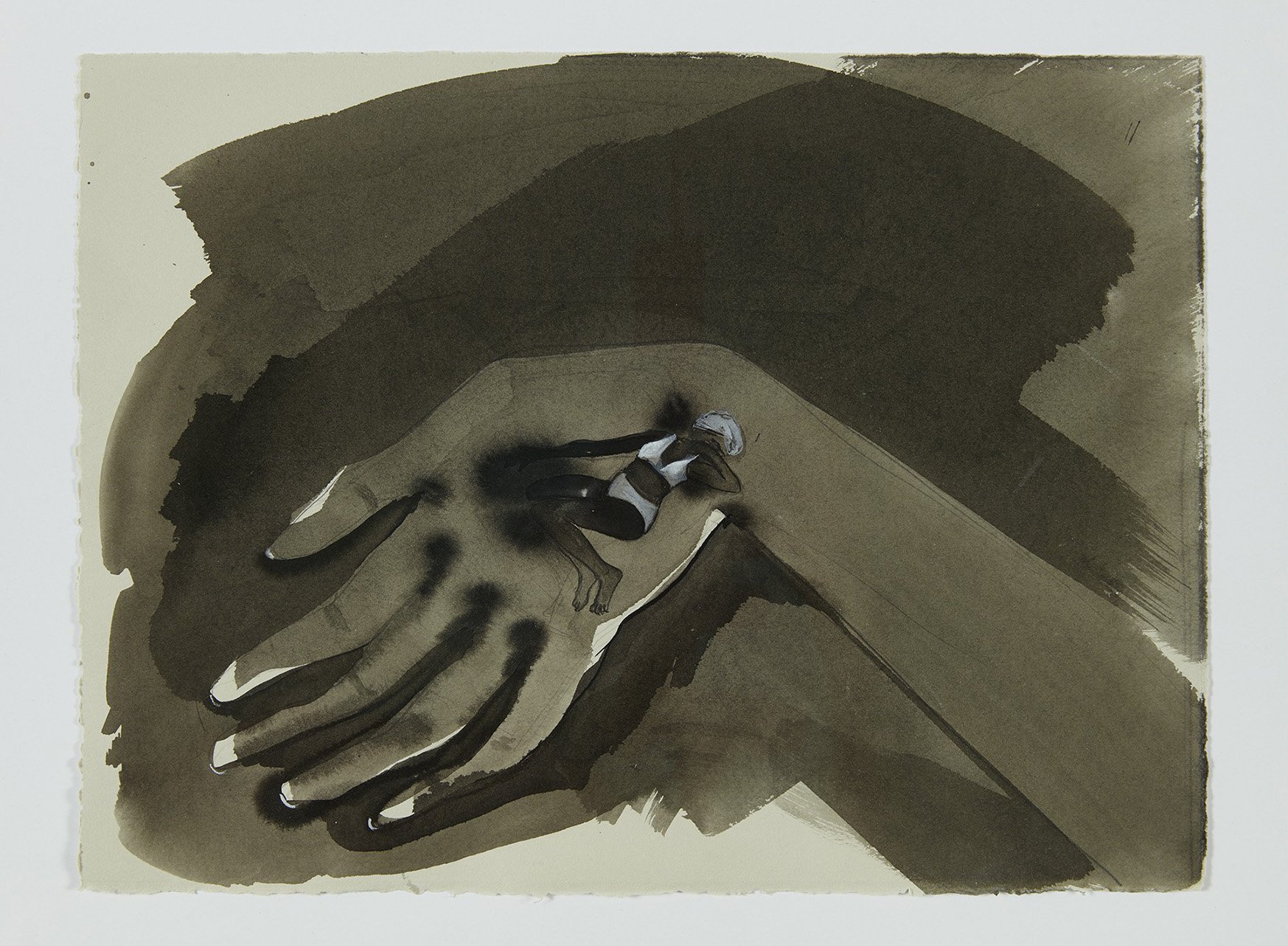
REVIEW: Kara Walker, “Back of Hand” at the Poetry Foundation
Kara Walker's new show currently up at the Poetry Foundation is quiet, meditative, discreet and a welcome and refreshing departure from the usually iconoclastic and intense work that those accustomed to Walker's output would be familiar with. The title of the exhibition suggests a rebuff, a slap in the face, but also a familiarity, knowing something "like the back of your hand." “Back of Hand” displays works on paper by the American artist that foreground her long-term engagement with both language and text.
Featuring excerpts from a handmade 2015 book comprising of a series of 11 type-written pages with ink and watercolor illustration under-glass vitrines, and the large-scale drawings “The Ballad of How We Got Here” and “Feast of Famine,” installed in the lobby, the exhibition contends directly with the contradictions of misremembered histories through Walker's pointed representation of the horrors beneath the antebellum South's genteel facades.

REVIEW: Christine Tarkowski, “the old Moon in the new Moon's arms” at the Arts Club of Chicago
Taut wires on the west side of the Arts Club building run from a fence to the base of the roof. Amorphous metallic forms hang along their length. I’d bet that upon being asked “What is this thing?” most passersby couldn’t come up with “a sculpture.” It possesses the quotidian look of windchimes, not the assertive indecipherability of high art, and blends imperceptibly with the greater sights and sounds of the city. But it is there, in a handful of wispy, lustrous presences. And it is watching.
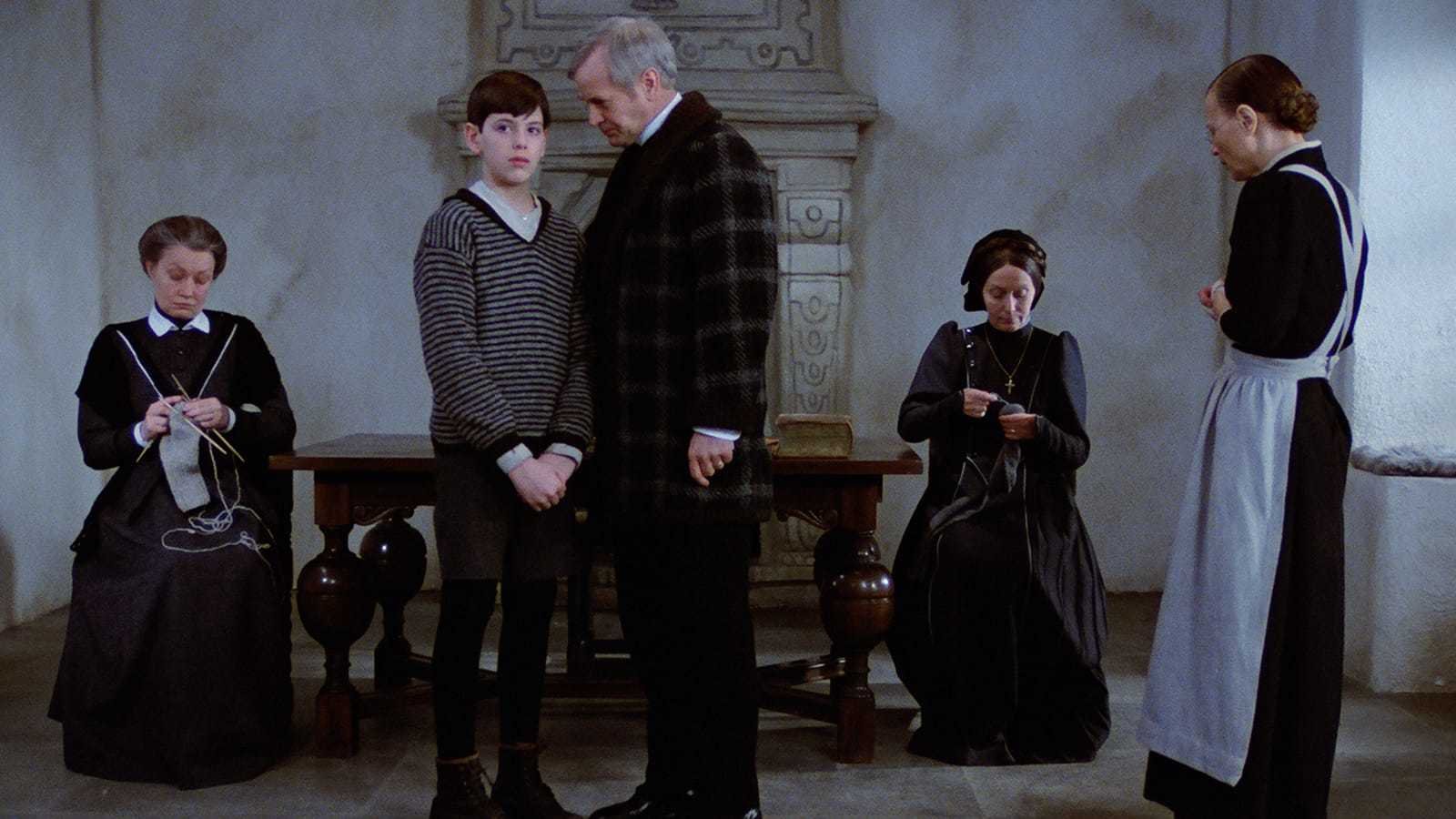
REVIEW: “Fanny and Alexander” at the Gene Siskel Film Center
In February, the Gene Siskel Film Center concluded their second annual Settle In series with a screening of Ingmar Bergman’s 1982 epic, Fanny and Alexander. The series, which aired over January and February, put its focus on long films- films that, through their extended runtime, require the viewer to, well, settle in.
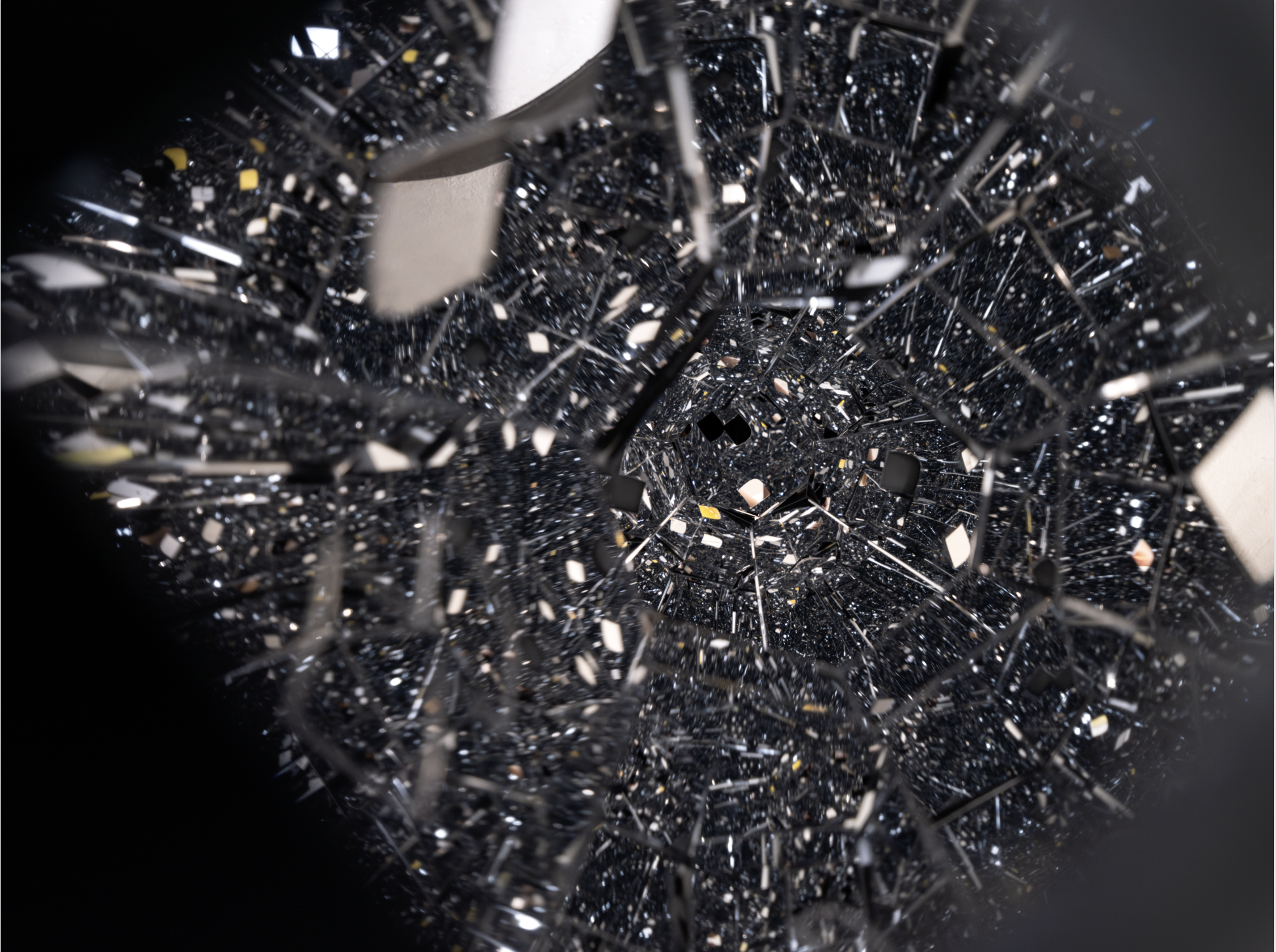
REVIEW: The Perspective of Nothingness; Chicago Works: Maryam Taghavi مریم تقوی at the MCA Chicago
A dot in the English language is a conclusion. A period, an ellipse — a dot is where things end. Nothing else shall be said. It is absolute.
A similar absoluteness is present in the Farsi dot, known as the “noghte.” Its quantity and placement define and significantly alter a letterform’s pronunciation and, therefore, its meaning. The noghte gives birth to all meanings in the language, like a seed imprinted with a tree’s DNA in its entirety.
So, what happens if absoluteness becomes abstract, definitions blur into interpretations, and ambiguities replace clarities? What happens when everything is replaced with nothingness and predefined concepts are erased? Is the remainder endless possibilities or unfathomable chaos when all external definitions are removed? Does the perspective of nothingness invite, interrogate, or intimidate?










